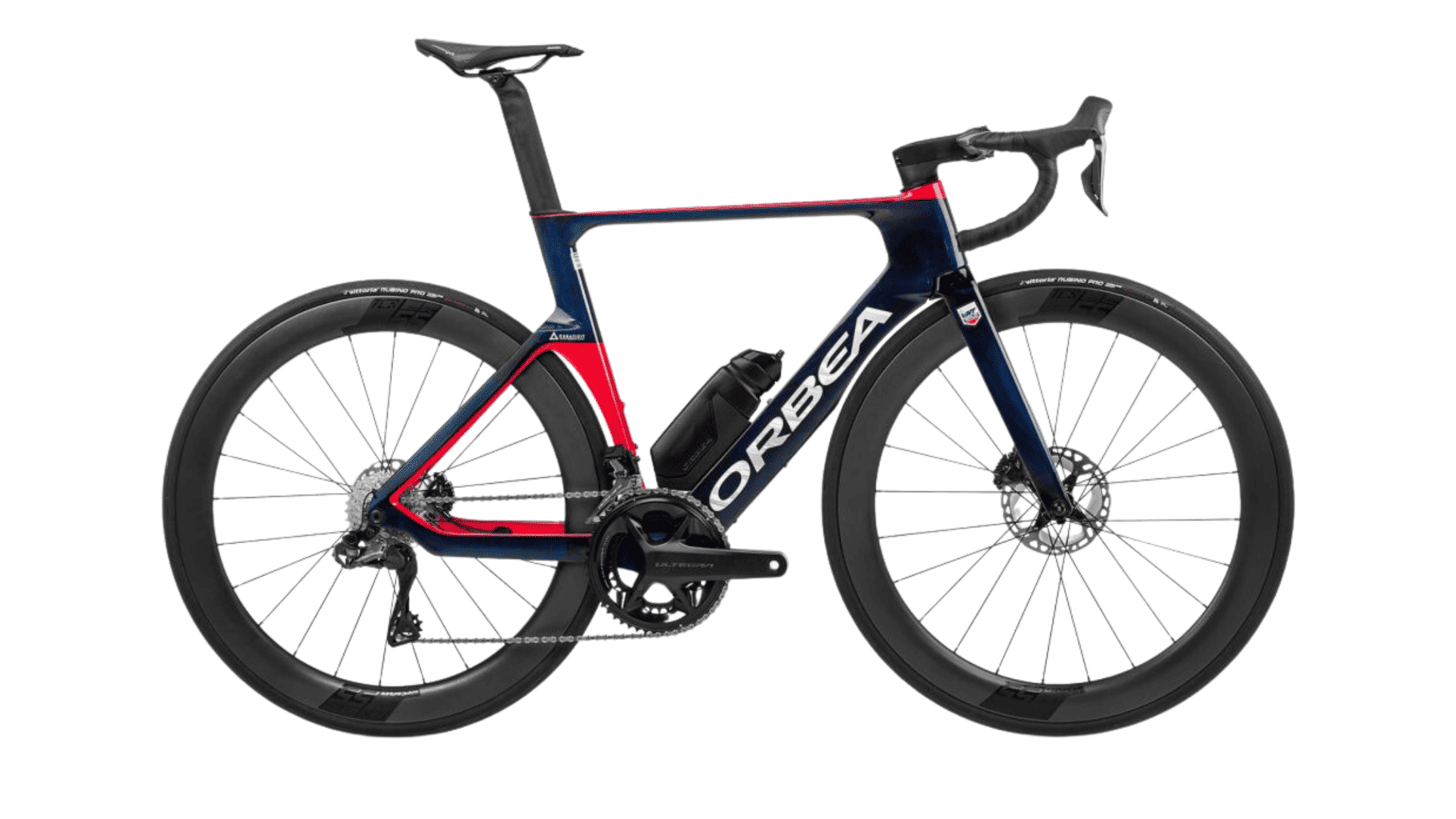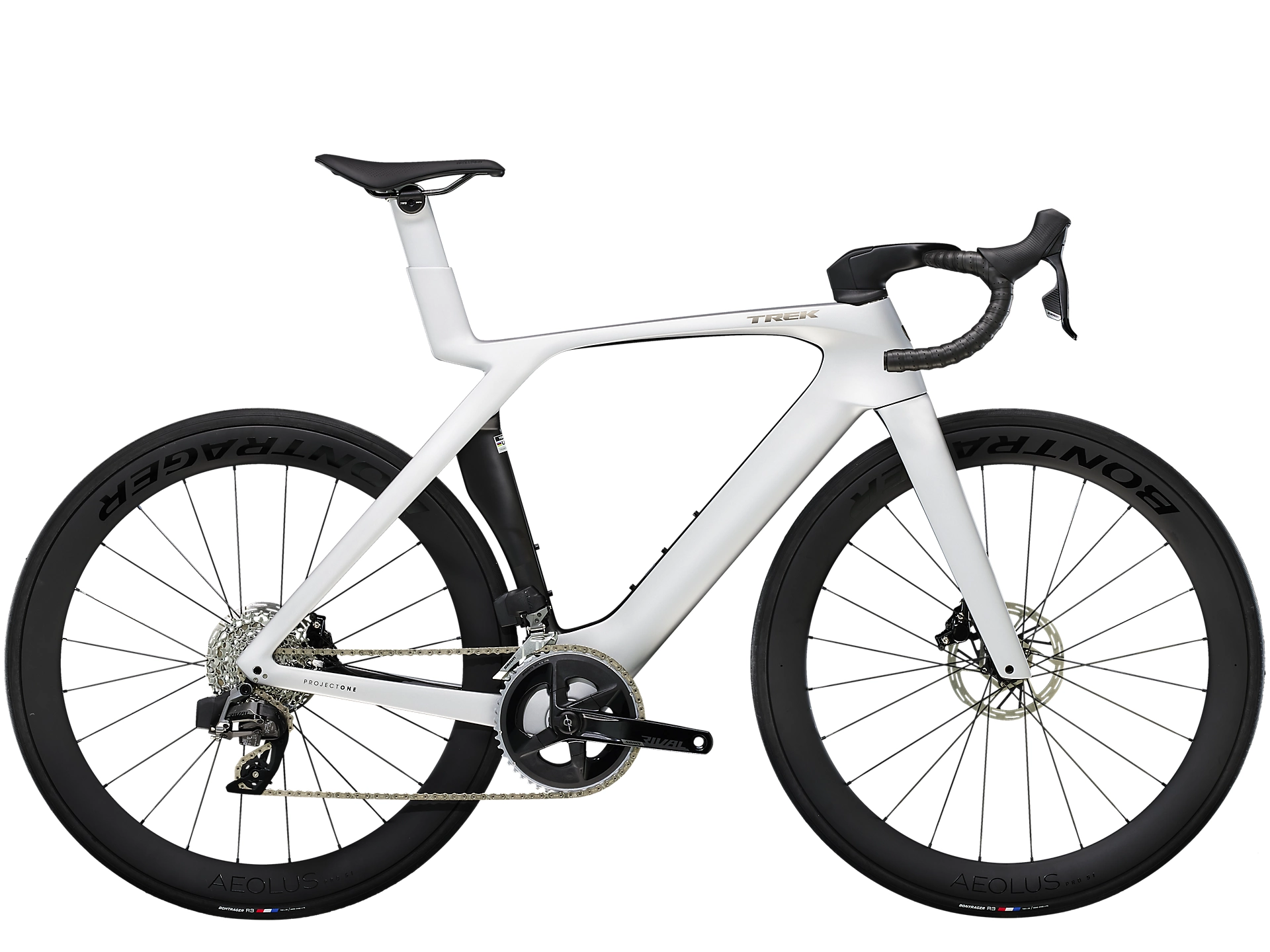In this comparison, I’ll dissect two popular bike models; the Orbea Orca Aero vs Trek Madone.
I’ll compare their lineups, bike specifications, and suggested retail prices in USD, then discuss the carbon fiber technology (Orbea Monocoque (TorayCa) Carbon and Trek OCLV) and frameset technologies.
The goal is to give you a better understanding of Orbea Orca Aero and Trek Madone to help in your decision-making.
| Orbea Orca Aero | Trek Madone | |
|---|---|---|
| Type of bike | Aero | Aero |
| Frame material | OMX (Toray T1100) carbon | OCLV 800 carbon OCLV 500 carbon |
| Frame sizes | 47, 49, 51, 53, 55, 57, 60 | 47, 50, 52, 54, 56, 58, 60, 62 |
| Groupset | Shimano, SRAM (12-speed) | Shimano, SRAM (12-speed) |
| Brakes | Hydraulic disc | Hydraulic disc |
| Cabling | Internal | Internal |
| Price (USD) | $4,899 to $10,899 | $5,199 to $13,199 |
Orbea Orca Aero

The Orbea Orca Aero combines the design principles of the Orca Orca road and the Ordu time trial bike. It uses Toray’s T1100 monocoque carbon, which Orbea refers to as OMX carbon.
The most obvious and standout feature of the Orca Aero is the aero water bottle and storage box beneath the down tube. They are optional and can be removed, depending on your preferences.
The Orbea Orca Aero offers you a lot of customization options from frame color, groupset, wheelset, tires, and saddle using the MyO configurator. There are 6 models available with either Shimano or SRAM electronic shifting groupsets.
| Model | Frame material | Groupset | Wheelset | Retail price (USD) |
|---|---|---|---|---|
| Orbea Orca Aero M10iLTD | OMX (Toray T1100) carbon | Shimano Dura-Ace Di2 (R9200) | Shimano Dura-Ace C50 | $10,899 |
| Orbea Orca Aero M11eLTD | OMX (Toray T1100) carbon | SRAM Red eTap AXS | Vision 55 SC | $9,899 |
| Orbea Orca Aero M20iLTD | OMX (Toray T1100) carbon | Shimano Ultegra Di2 (R8100) | Vision 55 SC | $6,799 |
| Orbea Orca Aero M21eLTD | OMX (Toray T1100) carbon | SRAM Force eTap AXS | Vision 55 SC | $6,799 |
| Orbea Orca Aero M31eLTD | OMX (Toray T1100) carbon | SRAM Rival eTap AXS | Vision 40 SC | $5,699 |
| Orbea Orca Aero M30iLTD | OMX (Toray T1100) carbon | Shimano 105 Di2 (R7100) | Vision 40 SC | $4,899 |
Orbea Orca Aero vs others
Trek Madone

Dubbed the ultimate superbike, the Trek Madone is all about maximizing aerodynamics and speed.
Trek refreshed the Madone in June 2022, just before the Tour de France started. The new Trek Madone features a radical-looking seat tube with a big hole. The previous IsoSpeed system, which allows the seatpost to flex for extra comfort, is replaced by the IsoFlow Technology. According to Trek, the IsoFlow technology adds an aerodynamic advantage, reduces weight, and smooths the road ahead.
The range-topping Madone SLR is built on the Trek’s lightest OCLV 800 carbon, with a one-piece carbon handlebar. The Madone SL models are still based on the previous Madone frame design and use the OCLV 500 carbon.
The Madone SLR frameset is also available separately.
| Model | Frame material | Groupset | Wheelset | Retail price (USD) |
|---|---|---|---|---|
| Trek Madone SLR 9 AXS | OCLV 800 carbon | SRAM Red eTap AXS | Bontrager Aeolus RSL 51 | $13,199 |
| Trek Madone SLR 9 | OCLV 800 carbon | Shimano Dura-Ace Di2 (R9200) | Bontrager Aeolus RSL 51 | $12,749 |
| Trek Madone SLR 7 AXS | OCLV 800 carbon | SRAM Force eTap AXS | Bontrager Aeolus Pro 51 | $9,699 |
| Trek Madone SLR 7 | OCLV 800 carbon | Shimano Ultegra Di2 (R8100) | Bontrager Aeolus Pro 51 | $9,049 |
| Trek Madone SLR 6 AXS | OCLV 800 carbon | SRAM Rival eTap AXS | Bontrager Aeolus Pro 51 | $8,399 |
| Trek Madone SLR 6 | OCLV 800 carbon | Shimano 105 Di2 (R7100) | Bontrager Aeolus Pro 51 | $7,999 |
| Trek Madone SL 7 AXS | OCLV 500 carbon | SRAM Force eTap AXS | Bontrager Aeolus Pro 51 | $7,499 |
| Trek Madone SL 7 | OCLV 500 carbon | Shimano Ultegra Di2 (R8100) | Bontrager Aeolus Pro 51 | $6,999 |
| Trek Madone SL 6 | OCLV 500 carbon | Shimano 105 Di2 (R7100) | Bontrager Aeolus Elite 50 | $5,199 |
Orbea vs Trek carbon fiber
Orbea Monocoque (TorayCa) Carbon
Orbea uses carbon fiber from TorayCa in their bikes. It’s one of the handful of bike manufacturers that uses a monocoque carbon fiber construction, resulting in a lighter and stiffer frameset. The two most prominent types of carbon used in Orbea’s bike frames are OMX (T1100K) and OMR (T800) carbon.
- OMX (Orbea Monocoque X) carbon is Orbea’s top-grade carbon fiber, with the ultimate blend of stiffness, lightness, and strength. Monocoque refers to a type of construction technique where the external skin supports the structural load, which, when applied to bike frames, results in a balance of strength and weight. Due to its high manufacturing cost, OMX carbon is typically reserved for Orbea’s top-tier models.
- OMR (Orbea Monocoque Race) is the standard carbon composite used by Orbea. While OMR doesn’t match the absolute performance capabilities of OMX, it offers a fantastic performance-to-value ratio. This makes it a great choice for riders looking for top-notch performance without the premium price tag of the top-grade OMX carbon.
Trek OCLV carbon
The OCLV (Optimum Compaction, Low Void) carbon is a proprietary carbon fiber manufacturing technology developed by Trek.
- Optimum Compaction refers to the heat and pressure applied during the curing process to squeeze out excess resin and ensure that the carbon layers are compacted to the optimal density.
- Low Void refers to the goal of reducing microscopic air pockets or voids that can occur in the carbon fiber and create weaknesses.
One of the key advantages of OCLV carbon is its ability to achieve an optimal balance between stiffness, strength, and weight. Trek engineers carefully tune the carbon layup and utilize varying modulus carbon fibers to create stiff frames in certain areas to maximize power transfer while maintaining compliance in other areas to enhance comfort and ride quality.
The OCLV carbon is available in 800 and 500 series.
- OCLV 800 is the highest-grade carbon fiber used by Trek. The carbon modulus is higher in OCLV 800, making it stiffer and lighter. The manufacturing process is more refined, using more advanced carbon and resins, leading to a bike frame that provides top performance levels for stiffness, weight, and strength. OCLV 800 is used in all models with SLR.
- OCLV 500 is a lower-grade carbon but still offers a high level of performance. It has a slightly lower carbon modulus, meaning it’s a bit less stiff and heavier than OCLV 800. OCLV 800 is used in all models with SL.
It’s worth noting that the different OCLV grades don’t only refer to the material itself, but also to the manufacturing techniques used to form the carbon fiber into bike frames. Higher-grade carbon requires more precise manufacturing techniques to take full advantage of its superior material properties.
Frameset technologies and innovations
Orbea Orca Aero and Trek Madone framesets incorporate advanced technologies to enhance their bikes’ performance and ride characteristics.
Here’s an overview of the technologies used in each bike model.
Orbea Orca Aero
| Name | Description |
|---|---|
| Monocoque Carbon Construction | Monocoque carbon construction is a process that uses the most advanced carbon technology to create the most sophisticated bike frames possible. Monocoque means that the frame is made of a single piece of carbon fiber, rather than multiple pieces joined together. This ensures that the frame is lighter, stiffer, and stronger, as there are no weak points or excess material. Orbea has two grades of carbon fibers; OMX (Orbea Monocoque X-Light) and OMR (Orbea Monocoque Race). Orbea also uses a bladder molding technique with EPS (expanded polystyrene) forms and PU (polyurethane) inserts to prevent wrinkles and gaps in the carbon layers, which can compromise the quality and durability of the frame. |
| TrueAero | TrueAero is a combination of shapes, sizes, and materials that optimize airflow across the entire bike. TrueAero carbon is used to construct the Orca frame, which is designed to reduce drag and increase speed. TrueAero also includes features such as an integrated stem and handlebar, hidden cables, and an aero seatpost. |
| ICR | This stands for Internal Cable Routing, which is a system that routes all the cables neatly through the bar, stem, and headset for a clean look and improved aerodynamics. ICR also makes it easier to maintain and service the bike compare to other bike brands’ solutions. |
Trek Madone
| Name | Description |
|---|---|
| OCLV Carbon | Optimum Compaction, Low Void (OCLV). A carbon fiber technology used in Trek frames. Employs advanced layup techniques and precise carbon compaction to create lightweight, strong frames with a balanced blend of stiffness and compliance. Available in two grades; OCLV 800 and 500. A higher number indicates a higher grade carbon. |
| H1.5 geometry | Trek’s geometry design that strikes a balance between aggressive racing positioning (H1) and rider comfort (H2). H1.5 geometry provides a slightly more relaxed riding position than the racier H1 geometry, making it suitable for a wider range of riders. |
| IsoFlow Technology | A design element in Trek’s new Madone road bike that replaces the previous IsoSpeed technology. The aim is to improve the overall aerodynamic performance, reduce weight, and provide ride comfort by effectively managing airflow and reducing drag in the seat tube area. |
| IsoSpeed Technology | An innovative solution for improving rider comfort on rough surfaces. The IsoSpeed decoupler allows the seat tube to flex independently from the rest of the frame, increasing vertical compliance and smoothing road vibrations. |
| Kammtail Virtual Foil (KVF) | An aerodynamic tube shaping technology used on the Trek Madone. The trailing edge of a traditional airfoil is truncated, creating a virtual tail effect that maintains aerodynamic efficiency while offering a more practical and versatile design. |
| Project One | Trek’s customization program that allows riders to create personalized and unique bikes. With Project One, riders can customize various aspects of their bikes, including frame color, paint scheme, components, drivetrain, wheels, and other details. |
Where to buy
Orbea retailers
- Orbea retailers. Use this tool to find your nearest Orbea dealers.
Trek shops
- Trek online shops. Australia, Austria, Canada, Germany, Netherlands, United Kingdom, United States
- Trek retailers. Use this tool to find your nearest Trek retailers.

Bernard Lu has 7+ years of experience working in a bicycle shop, overseeing the retail and workshop operations. He’s a qualified bicycle mechanic who understands a cyclist’s needs and speaks the same cycling lingo.
If you meet him at the cafe, he will happily talk to you for hours about all the intricacies of bikes and cycling tech. Just buy him a coffee next time you see him.